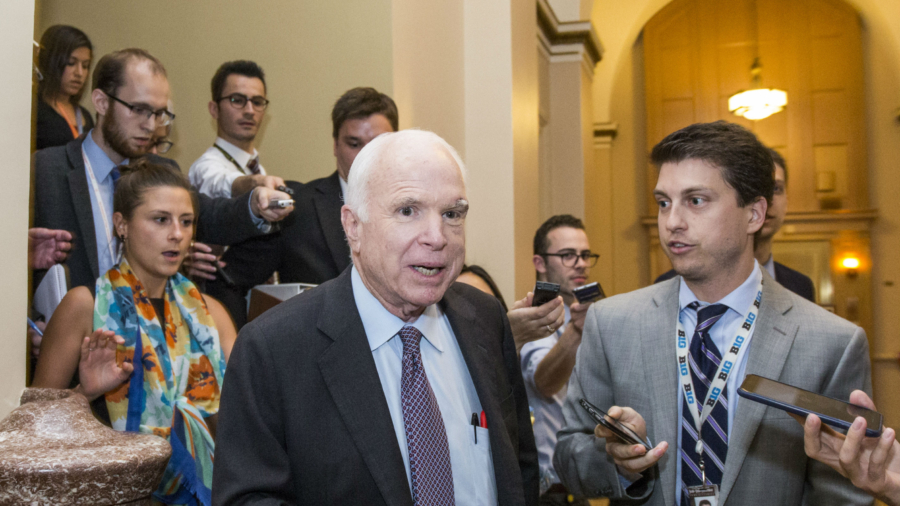The U.S. Senate Republican majority fell one vote short of passing a bill that would have repealed parts of the Affordable Care Act (“Obamacare”) on Friday, July 28.
Three Republican senators—John McCain, Susan Collins, and Lisa Murkowski—joined Senate Democrats in the early-morning 51-49 vote rejecting the bill.
A legislation that would have repealed “Obamacare”more broadly failed earlier in the week.
“It’s time to move on,” said Senate Majority Leader Mitch McConnell on the Senate floor after the vote that took place at roughly 1:30 a.m.
“This is clearly a disappointing moment,” McConnell added. “The American people are going to regret that we couldn’t find a better way forward.”
Republicans hold a 52-48 majority in the 100-seat Senate and could afford to lose support from only two Republican senators, with Vice President Mike Pence ready to cast a tie-breaking vote on the Senate floor.
Failure to repeal “Obamacare” blocks President Donald Trump’s legislative agenda that, aside from health care legislation, includes tax cuts and a boost in infrastructure spending.
“3 Republicans and 48 Democrats let the American people down. As I said from the beginning, let ‘Obamacare’ implode, then deal. Watch!” Trump wrote on Twitter after the vote.
“Obamacare” introduced a system of health care taxes and subsidies and forced Americans to buy health insurance to avoid paying a penalty. It imposed many more regulations, including stipulating a set of health problems that must be covered by every insurance and prohibiting insurers from penalizing people applying for insurance who are already sick. That led to about 10 million uninsured people getting insurance.
However, it also led to rising costs for insurers, who responded by raising premiums or quitting the “Obamacare” insurance markets, signaling a possible upcoming collapse of the “Obamacare” market.
Individuals buying insurance in 39 states that use the federal “Obamacare” exchange (healthcare.org) have seen their premiums more than double since “Obamacare” was enactment in 2013. For most of them, the growing tab is partially picked up by taxpayers through federal subsidies. But that doesn’t apply to deductibles. In 2014, a family on a “Silver” plan had to pay about $6,000 out of pocket before their insurance kicked in. In 2017, the deductible grew to almost $13,000.
Meanwhile, almost 40 percent of counties are left with only one available insurer on their exchanges, estimated Health and Human Services Secretary Tom Price. That counters “Obamacare’s” promise to bring down health care costs through competition.
Starting this year, insurers may have added an extra premium hike to hedge uncertainty on whether “Obamacare” will stay or go.
“Obamacare” also expanded Medicaid. Previously, the federal program served the poor in the following categories: the elderly, parents, pregnant women, and children. It also served the blind and disabled. “Obamacare” expanded Medicaid to serve abled-bodied adults who made less than 138 percent of the federal poverty level.
Some 11 million took advantage of the expansion.
But Medicaid had already struggled with rising costs, while also paying doctors on average about half the reimbursement private insurance would pay. That’s primarily why about 1 in 3 physicians doesn’t accept new Medicaid patients, compared to about 1 in 6 for private insurance patients.
A 2013 study in Oregon showed Medicaid patients achieved no better health results than the uninsured on several indicators like elevated blood pressure and risk of cardiovascular disease.
Republicans kept the text of their skinny “Obamacare” repeal under wraps until three hours before voting began. It would have retroactively repealed “Obamacare’s” penalty on individuals who do not obtain health insurance, repealed for eight years a penalty on certain businesses that do not provide employees with insurance, and repealed a tax on medical devices until 2020.
The nonpartisan Congressional Budget Office estimated that if the bill would have become a law, 15 million fewer Americans would be insured in 2018 than under existing law. That estimate is based on an assumption that about 7 million people would enroll into “Obamacare” by next year to avoid the rising penalty for not having an insurance ($695 since 2016). It also expects millions would discard insurance when no longer threatened by the penalty. Some experts argued the penalty doesn’t have so great an effect and that “Obamacare” mostly worked through Medicaid expansion and subsidies.
The failure of Republican efforts to repeal and replace “Obamacare” stems from opposing views on how to proceed. Some Senators give priority to reducing government manipulation of healthcare industry. Others prioritize preserving entitlements of Obamacare.
Reuters and The Epoch Times Stephen Gregory contributed to this report.

